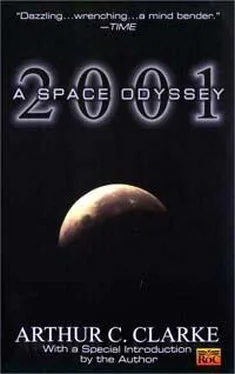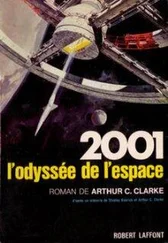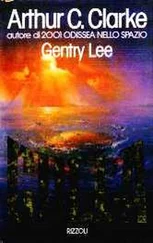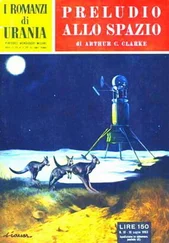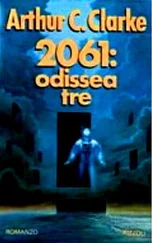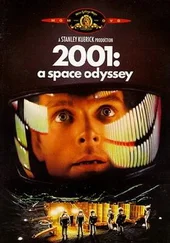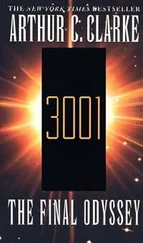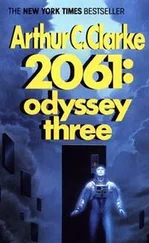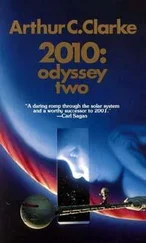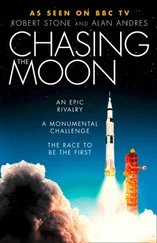He tried to avoid thinking about such long-range problems, and to concentrate on immediate essentials. Slowly, he cleaned up the ship, checked that its systems were still running smoothly, discussed technical difficulties with Earth, and operated on the minimum of sleep. Only at intervals, during the first weeks, was he able to give much thought to the great mystery toward which he was now inexorably racing – though it was never very far from his mind.
At last, as the ship slowly settled down once more into an automatic routine – though one that still demanded his constant supervision – Bowman had time to study the reports and briefings sent to him from Earth. Again and again he played back the recording made when TMA-1 greeted the dawn for the first time in three million years. He watched the spacesuited figures moving around it, and almost smiled at their ludicrous panic when it blasted its signal at the stars, paralyzing their radios with the sheer power of its electronic voice.
Since that moment, the black slab had done nothing. It had been covered up, then cautiously exposed to the Sun again – without any reaction. No attempt had been made to cut into it, partly through scientific caution, but equally through fear of the possible consequences.
The magnetic field that led to its discovery had vanished at the moment of that radio shriek. Perhaps, some experts theorized, it had been generated by a tremendous circulating current, flowing in a superconductor and thus carrying energy down the ages until it was needed. That the monolith had some internal source of power seemed certain; the solar energy it had absorbed during its brief exposure could not account for the strength of its signal.
One curious, and perhaps quite unimportant, feature of the block had led to endless argument The monolith was 11 feet high, and 11/4 by 5 feet in cross-section. When its dimensions were checked with great care, they were found to be in the exact ratio 1 to 4 to 9 – the squares of the first three integers. No one could suggest any plausible explanation for this, but it could hardly be a coincidence, for the proportions held to the limits of measurable accuracy. It was a chastening thought that the entire technology of Earth could not shape even an inert block, of any material, with such a fantastic degree of precision. In its way, this passive yet almost arrogant display of geometrical perfection was as impressive as any of TMA-l's other attributes.
Bowman also listened, with a curiously detached interest, to Mission Control's belated apologia for its programming. The voices from Earth seemed to have a defensive note; be could imagine the recriminations that must now be in progress among those who had planned the expedition.
They had some good arguments, of course – including the results of a secret Department of Defense study, Project BARSOOM, which had been carried out by Harvard's School of Psychology in 1989. In this experiment in controlled sociology, various sample populations had been assured that the human race had made contact with extraterrestrials. Many of the subjects tested were – with the help of drugs, hypnosis, and visual effects – under the impression that they had actually met creatures from other planets, so their reactions were regarded as authentic.
Some of these reactions had been quite violent; there was, it seemed, a deep vein of xenophobia in many otherwise normal human beings. In view of mankind's record of lynchings, pogroms, and similar pleasantries, this should have surprised no one; nevertheless, the organizers of the study had been deeply disturbed, and the results had never been released. The five separate panics caused in the twentieth century by radio broadcasts of H.G. Wells's War of the Worlds also reinforced the study's conclusions.
Despite these arguments, Bowman sometimes wondered if the cultural shock danger was the only explanation for the mission's extreme secrecy. Some hints that had been dropped during his briefings suggested that the U.S.-U.S.S.R. bloc hoped to derive advantage by being the first to contact intelligent extraterrestrials.
From his present viewpoint, looking back on Earth as a dim star almost lost in the Sun, such considerations now seemed ludicrously parochial.
He was rather more interested – even though this was now very much water under the bridge – in the theory put forward to account for Hal's behavior. No one would ever be sure of the truth, but the fact that one of the Mission Control 9000s had been driven into an identical psychosis, and was now under deep therapy, suggested that the explanation was the correct one. The same mistake would not be made again; and the fact that Hal's builders had failed fully to understand the psychology of their own creation showed how difficult it might be to establish communication with truly alien beings.
Bowman could easily believe Dr. Simonson's theory that unconscious feelings of guilt, caused by his program conflicts, had made Hal attempt to break the circuit with Earth. And he liked to think – though this again was something that could never be proved – that Hal had no intention of killing Poole. He had merely tried to destroy the evidence; for once the AE-35 unit reported as burned out was proved to be operational, his lie would be revealed. After that, like any clumsy criminal caught in a thickening web of deception, he had panicked.
And panic was something that Bowman understood better than he had any wish to, for he had known it twice during his life. The first time was as a boy, when he bad been caught in a line of surf and nearly drowned; the second was as a spaceman under training, when a faulty gauge had convinced him that his oxygen would be exhausted before he could reach safety.
On both occasions, he had almost lost control of all his higher logical processes; he had been within seconds of becoming a frenzied bundle of random impulses. Both times he had won through, but he knew well enough that any man, in the right circumstances, could be dehumanized by panic.
If it could happen to a man, then it could happen to Hal; and with that knowledge the bitterness and the sense of betrayal he felt toward the computer began to fade. Now, in any event, it belonged to a past that was wholly overshadowed by the threat, and the promise, of the unknown future.
Apart from hasty meals back in the carrousel – luckily the main food dispensers had not been damaged – Bowman practically lived on the control deck. He catnapped in his seat, and so could spot any trouble as soon as the first signs of it appeared on the display. Under instructions from Mission Control, he had jury-rigged several emergency systems, which were working tolerably well. It even seemed possible that he would survive until the Discovery reached Saturn – which, of course, she would do whether he was alive or not.
Though he had little enough time for sightseeing, and the sky of space was no novelty to him, the knowledge of what now lay out there beyond the observation ports sometimes made it difficult for him to concentrate even on the problem of survival. Dead ahead, as the ship was now oriented, sprawled the Milky Way, with its clouds of stars so tightly packed that they numbed the mind. There were the fiery mists of Sagittarius, those seething swarms of suns that forever hid the heart of the galaxy from human vision. There was the ominous black shadow of the Coal Sack, that hole in space where no stars shone. And there was Alpha Centauri, nearest of all alien suns – the first stop beyond the Solar System.
Although outshone by Sirius and Canopus, it was Alpha Centauri that drew Bowman's eyes and mind whenever he looked out into space. For that unwavering point of brightness, whose rays had taken four years to reach him, had come to symbolize the secret debates that now raged on Earth, and whose echoes came to him from time to time.
Читать дальше
